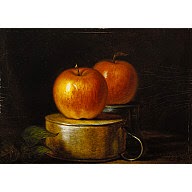Tomato Ketchup.- Take two dozen of ripe tomatas and a handful of salt; slice the tomatas, and put a layer into a jar, sprinkle salt over it, then another layer of tomatas and salt, until the jar is full. Stir the contents now and then for three or four days, keeping the jar in a warm place by the fire; at the expiration of which time press the juice from the tomatas by rubbing them with a wooden spoon through a sieve, and boil it with mace, pepper, allspice, ginger and cloves, in the proportion of about two ounces in all to one quart of juice, a few blades of mace, twelve cloves, a spoonful of pounded ginger, and the remainder pepper and allspice. In three months boil it again with fresh spice. Or:-Take six pounds of tomatas, sprinkle them with salt; let them remain for a day or two, then boil them until the skins will separate easily; pour them into a colander, or coarse sieve, and press them through, leaving the skins behind; put into the liquor one handful of shalots, one pint of Chili vinegar, half pint wine, pepper, cloves, ginger, and allspice; boil them together until a third part has wasted; then bottle it, closing the bottle securely. It must be shaken before it is used.
Tomato Sauce for Winter.- Use one peck of tomatas, six onions sliced, two heads of celery, a dozen shalots, one ounce of cayenne pepper, half ounce of black pepper, and one ounce of mace in powder. Slice them into a well-tinned saucepan, mixing the seasoning with them as they are cut up; boil, keeping them well stirred; when thoroughly soft, drain off the water, and rub through a hair sieve. Boil it again until it is as thick as apple-sauce. Put it into bottles, and cork close. Put the bottles into a stewpan, fill it with cold water, let it boil for twenty minutes. Keep in a cool place. Examine the bottles occasionally, and if there is the least indication of a change turn it into the kettle again, boil, and scum it, keeping it well stirred from the bottom that it may not adhere, and put it into the bottles again. When required for use, warm what is wanted with a little gravy. It is as nice as when fresh done, and will be found excellent with calf's-head or brains, veal, beef, mutton, pork, or goose. An onion or a shallot, boiled in the gravy with which it is mixed, will be an improvement.
Lemon Cakes.- Quarter as many lemons as you think proper: they must have good rinds. Boil them in two or three waters till they are tender and have lost their bitterness. Then skin them and put them in a napkin to dry. With a knife take all the skins and seeds out of the pulp: shred the peels fine, and put them to the pulp. Weigh them, and put rather more than their weight of fine sugar into a stewpan, with just sufficient water to dissolve the sugar. Boil it till it becomes perfectly dissolved, and then, by degrees, put in the peel and pulps. Stir them well before you set them on the fire. Boil the whole very gently until it looks clear and thick, and then put it into flat-bottomed glasses. Set them in a stove and keep them in a continual and moderate heat, and turn them out upon glasses as soon as they are candied.
Orange Custards.- Having boiled the rind of a Seville orange very tender, beat it in a mortar to a fine paste. Put to it the juice of a Seville orange, a spoonful of the best brandy, four ounces of loaf sugar, and the yolks of four eggs; beat them all well together ten minutes. Then pour in by degrees a pint boiling cream; keep beating it till cold, and then put it into custard glasses. Place them in an earthen dish of hot water and let them stand till they are set; then stick preserved orange, or orange chips on the top. They may be served hot or cold.
Almond Pudding.- Blanch half a pound of sweet almonds and four bitter ones in warm water. Pound them in a marble mortar, with two spoonfuls of orange flower water, two of rose water, and a gill of white wine. Mix in four grated Naples biscuits, and three-quarters of a pound of melted butter. Beat eight eggs and mix them with a quart of boiled cream. Grate in half a nutmeg, add a quarter of a pound of loaf sugar, and mix all well together. Make a thin puff paste and lay it all over the dish. Pour in the ingredients and bake it.
Sago Pudding.- Boil two ounces of sago with some cinnamon, and a bit of lemon peel, till it becomes soft and thick. Mix the crumb of a small roll finely grated, with a glass of red wine, four ounces of chopped marrow, the yolks of four eggs well beaten, and sugar according to taste. When the sago is cold add this mixture to it; stir the whole well together, and put in a dish lined with a light puff paste, and set it in a moderate oven to bake. When done stick it all over with citron cut in pieces, and afterward blanched, and cut in slips.
 |
| Unidentified artist, American, mid-19th century, MFA |















